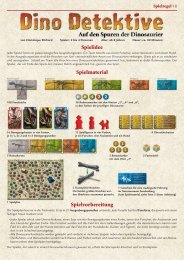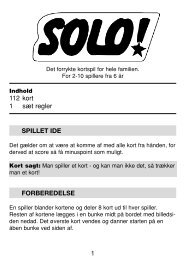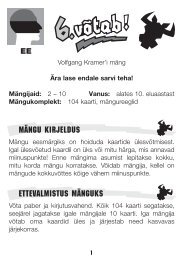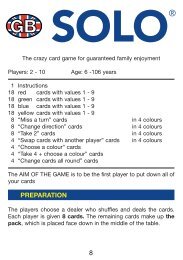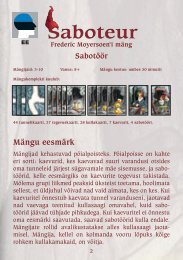Spielmaterial Spielziel Spielvorbereitung - AMIGO Spiel + Freizeit ...
Spielmaterial Spielziel Spielvorbereitung - AMIGO Spiel + Freizeit ...
Spielmaterial Spielziel Spielvorbereitung - AMIGO Spiel + Freizeit ...
Create successful ePaper yourself
Turn your PDF publications into a flip-book with our unique Google optimized e-Paper software.
7. If a player earns more than one lot of the same total of points during his turn (for example two 12s), he notes all<br />
these points (for example, 2 x 4 points = 8 points) in the next free box in the corresponding column “12 (4)”.<br />
8. For rows on the scoring sheet in which all three columns – the 10s, 11s and 12s – are filled in, the player<br />
receives the bonus points indicated on the sheet. If there is any entry missing, he does not get a bonus.<br />
9. If the row also contains a cross in the “x2” column, all the points noted in this row count double – regardless of<br />
whether the row is completed or not.<br />
10. If, at the end of the game, a player still has tiles in front of him on the table, the total of all of their dots are noted as<br />
negative points. Fill the number in the “Minus” box at the bottom of the scoring sheet.<br />
Hint: Adding up the points, you will recognize that it is not that important to earn as many 12s as you can, but rather to<br />
complete the rows from the top to the bottom – that means to note points evenly (because of the bonus points) and to<br />
get as many crosses in the “x2” column as possible.<br />
End of the game<br />
The game is over when a player draws the last tile out of the bag. He finishes his turn as usual (even if he only has drawn<br />
one tile so that he only can place this one on the table).You then add up all the points noted on your scoring sheet (and<br />
deduct negative points, if necessary).The player with the highest score wins the game.<br />
In rare cases, the game may have to end prematurely if no more tiles can be placed. In this case, players must draw the<br />
remaining tiles out of the bag in turns, one after another, until the bag is empty.All tiles that cannot be placed on the board<br />
count as negative points.<br />
Example for a final scoring. Andrew still has a tile in front of him on the table. His scoring sheet contains the following entries:<br />
Andrew<br />
( = (1 + 2 + 8 + 3) x 2 = 28)<br />
( = (1 + 2 + 4 + 3) x 2 = 20)<br />
( = (1 + 4) x 2 = 10)<br />
( = 1 + 4 = 5)<br />
This product has been manufactured to the highest quality standards. Should you be<br />
dissatisfied, please contact us directly.<br />
Do you have any questions? We would be delighted to help you.<br />
<strong>AMIGO</strong> <strong>Spiel</strong> + <strong>Freizeit</strong> GmbH,Waldstraße 23-D5, D-63128 Dietzenbach<br />
www.amigo-spiele.de, E-Mail: redaktion@amigo-spiele.de<br />
© <strong>AMIGO</strong> <strong>Spiel</strong> + <strong>Freizeit</strong> GmbH, D-63128 Dietzenbach, MMV Version 1.0<br />
8<br />
Variant for advanced players<br />
If you want to play ZATRE with 4 or 6<br />
players, you may also form pairs in<br />
order to compete against the other<br />
team(s).This variant requires a completely<br />
different strategy:<br />
Players sit next to each other in their<br />
teams.When it is their turn, both players<br />
simultaneously draw two tiles each<br />
out of the bag.They may then discuss<br />
how to best place the tiles.<br />
Afterwards, the results are noted on a<br />
common scoring sheet, one after the<br />
other.




